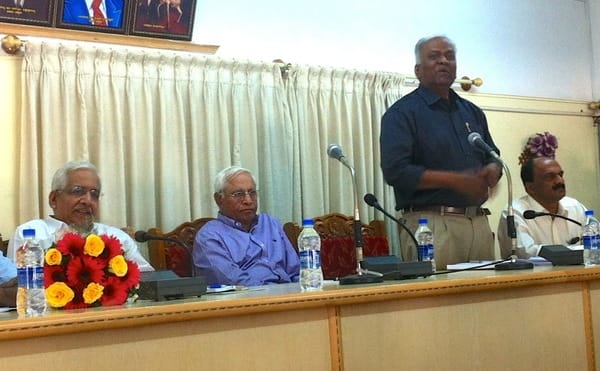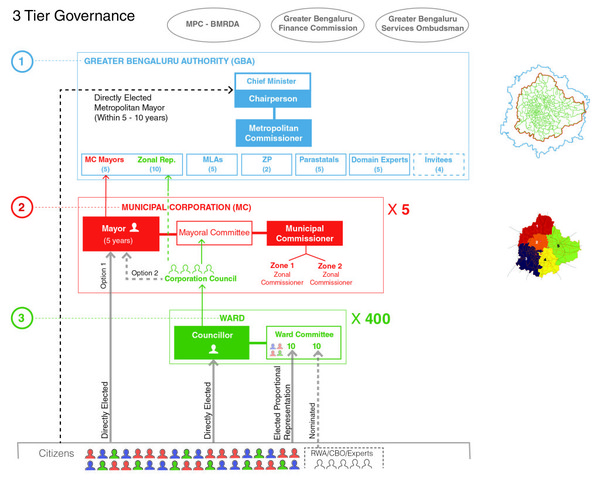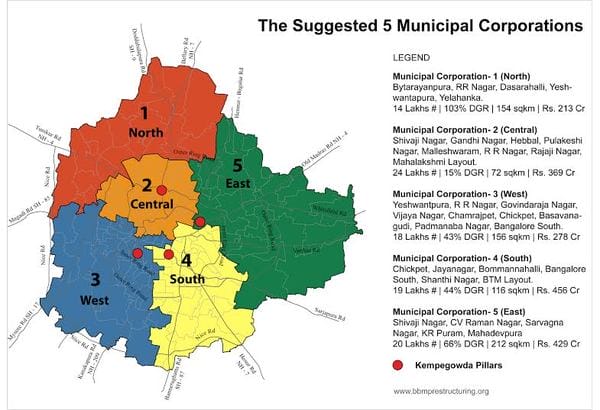
Public hearing on restructuring, held at Mahadevapura zonal office. From left: V Ravichandar, BS Patil, Siddaiah. Pic: Meera K
As a member of the BBMP Restructuring Committee, it’s been an exhilarating exercise engaging with city stakeholders, researching, evaluating options and finally putting out the report. And though this was a Monday morning release (wisely so, given the interest in Baahubali ), one got a sense of what a movie producer, director feels after the baby is out in public!
), one got a sense of what a movie producer, director feels after the baby is out in public!
There have been bouquets and brickbats. Firstly, thank you for the compliments and it was heartening to note that even the staunchest critics (‘the report has not addressed solutions’) acknowledge that the committee scored well on delineating the problem. I have been asked to respond to the concerns raised about some (many?) of the report’s recommendations and here’s my attempt to do that. It’s a tad long, but please bear with me.

A disclaimer is necessary before I proceed further. I write this note in my personal capacity as a committee member and do not claim to speak for the entire committee. So if anyone has any disagreements on my responses here, direct your missives at me. The committee’s considered views are in the report which is in the public domain (which incidentally was put up on the website within 10 minutes of handing over to the CM – hope we get some brownie points for setting some disclosure standards!).
Without much ado, let me dive into the issues raised in the media (in no particular order):
V Ravichandar
Criticism: Why Greater Bengaluru Authority (GBA)?
In a multi municipal corporation (which we have advocated with reasons in the report), we need an apex body. This is the proposed GBA level (Tier 1). Delhi’s problems with trifurcation are well documented. Part of their problem stems from the lack of a top tier body like the GBA.

3 tier governance by means of Greater Bengaluru Authority. Pic: www.bbmprestructuring.org
While the recommendation is in the spirit of decentralisation and devolution, we realise that a single ward cannot make the decision on say running a metro rail system for the city, just as a corporation which abuts other corporations cannot be making decisions outside their jurisdiction independently. In a similar vein, filling up potholes in a street is a decision that can be taken at a ward level and does not require consultation from the larger municipal corporation or the inter-municipal corporation coordinator.
The GBA hence is a critical level layer (including the clear demand of the people to reinforce ‘Brand Bengaluru’) for inter-municipal planning, coordination, integrating parastatals like BWSSB, BESCOM, BMTC, BDA, etc., decision making for sectors such as strategic projects, arterial roads, mass transportation, economic development planning, environmental networks, etc.
The rationale for GBA suggested itself while doing the detailed activity mapping exercise. Those interested could see Chapter 5 and Appendix III for what it implies, how it was done and finally the first cut activity mapping details. In essence, there is an ideal level (ward, zone/corporation, GBA) at which a particular task is best done. The GBA functions as we have envisaged is a response to the specific local conditions.
And there is the brand Bengaluru aspect, the one common thread across all our meetings. The feedback was to make sure brand Bengaluru is retained and strengthened. GBA allows that to be a reality. Further, sans GBA as the integration/coordination layer, the individual corporations could well end up directionless and working at cross purposes. The GBA layer will ensure Bengaluru works seamlessly as one integral entity which will help cement the brand identity.
Criticism: Why put the CM in charge of GBA for 5-10 years? This is regressive giving the State’s control over the city…
Many experts, civil society activists, civic evangelists (including yours truly) have cried themselves hoarse over the years about the undue influence (stranglehold?) of the State over city matters. Has it changed anything? If anything, it has got worse over the years as successive State governments have recognised the ‘promising’ characteristics of large, growing cities in the country. They have used multiple mechanisms to control the city through administrative measures, legislative powers, withholding grants, notification/de-notification and then some more. This to my mind is akin to back seat driving, power without accountability. One would rather have them occupy the visible front seat, with clear bottom line accountability for their actions.
We also have a legacy problem. This State control has strengthened over time. For instance, we today have parastatals like BWSSB, BDA, BMTC, BESCOM, etc. which operate in silos taking their instructions and cues from the State. Putting this genie back in the box is not a task for mere mortals, even directly elected metropolitan mayors. On the principle of ‘You broke it, you fix it’, the State (through the office of the CM) has a responsibility to set it right for a future day city leadership to take over the reins. In our current system, no one else has a remote chance of getting our parastatals to fall in line. Hence the suggestion of handing over the reins to the CM. Yes, there are valid concerns that they may never vacate the chair (within 5-10 years as recommended) and it may need citizen pressure and vigilance to ensure it does happen.
Do read Chapter 4. The CM is the head of the GBA, but the decisions are taken by the majority. And 22 of the 34 GBA members are from the 5 Corporations and the Zilla Parishads within the GBA limits. So it’s an oversimplification to assume that the CM has unbridled powers at the GBA. There are checks and balances built in.
The GBA is a new institution. It will take time to mature and for it to succeed it needs a politically strong leader. Further, if the party at the State level is different from the one ruling the corporation, strangulating grant flows is one of the approaches that end up impacting Bengalureans negatively. During the CM led arrangement, we de-risk that occurrence from happening.
I believe the CM as GBA head is a necessary, good step in getting to the truly empowered Bengaluru of tomorrow. Techies will tell you that the transition from legacy to new age systems is no easy task. It’s the same in the real world of State-City governance handover. And by no means is it unconstitutional. Yes, the measure will need to be passed by the Legislature. In our meetings with elected representatives across the political spectrum, we got the sense of a consensus on a special Act for Bengaluru.
Criticism: The GBA ought to have been the Metropolitan Planning Committee (MPC)
Certainly not! In our interim report, we felt GBA at 1,307 sq kms (the BBMP + BDA area) could be the MPC platform, but on reconsideration with inputs from planning experts and the Dr Kasturirangan report, we decided that the MPC needed a larger regional footprint. In our report (Chapter 8), we have given detailed reasons why the MPC at Bengaluru Metropolitan Region (BMRDA) scale of 8,005 sq kms is a great solution, both for Bengaluru and the other local bodies outside GBA in the region.
A summary of the reasons on why the MPC of 8,005 sq kms is desirable:
-
Expansion in the neighbourhood of the GBA inevitable and we need a MPC at a larger scale to manage intra as well as inter settlement, economic integration and inclusiveness
-
Land development occurs prior to any government regulated expansion and hence planning for the future requires a larger jurisdiction
-
The current metropolitan region houses several ULBs that prepare their own master land use plans and projects. These are contiguous to GBA and needs a metropolitan regional authority for coordination, negotiation and cooperation purposes
-
If an MPC is set up at GBA, it will require a District Planning Committee (DPC) at the regional level for multi municipal and RLB coordination. Considering both an MPC and DPC will both require 2/3rd elected members this will be a mere duplication and contain two separate politically heavy organisations trying to determine Bengaluru’s future
-
Technically, the spirit of setting up the MPC is to coordinate plans of at least two or more Municipalities or Panchayats. The Development (Master) Plan despite splitting up of the BBMP will remain a single plan as it is one city and rules out any coordination of plans with other municipalities
-
The Bengaluru Metropolitan Region Development Authority (BMRDA) enabled by the BMRDA Act, currently prepares a Structure Plan for the region covering an area of 8,005 sq km. With this current institutional armature in place, improving its efficiency, functions and enabling mechanisms is a more viable and preferred option.
Under the setup we have proposed GBA, (1,307 sq kms) will be one of the Local Planning Authorities (LPA) under the MPC (8,005 sq kms). The GBA will also have political representation in the composition of the 60 member MPC at the BMRDA level.
Criticism: Do we need the BDA?
Yes we do, but certainly not in its current avatar! We need a restructured BDA that effectively addresses Planning, Plan enforcement, Municipalisation and Mega Infrastructure for GBA. It can be a handy vehicle to house these functions while clearly repurposing what it can do or not do under its considerable powers on land acquisition, plan sanctions, master planning, existing asset base, etc. In accordance with the 74th CAA, the Model Municipal Law allows Municipalities to directly provide or arrange through another agency any of the “core municipal services” so long as responsibility and accountability for the service remains with the municipality. Hence, the Bangalore Development Authority may provide the necessary technical and secretarial assistance to GBA since their jurisdictions are exactly the same (1,307 sq kms). BDA has presently no accountability to the elected city leadership and the reporting structure needs to be changed. BDA reporting to the GBA addresses this problem.
Criticism: Setting out the 5 Corporations

The proposed 5 corporations. Pic: Bengaluru: Way Forward
Concerns have been expressed about linguistic divisions (East has been mentioned as an example), parts of South in West, a single assembly constituency in multiple corporations and differences in financial resources across corporations. Well, we have the Greater Bengaluru Finance Commission to address money imbalances; the corporations have been drawn based on existing wards and not Assembly constituencies (which too will be delimited in a few years’ time); yes, looking at the map West does need to be called ‘South West’ (and it could be as successful as the airline that goes by that name!).
On linguistic aspects, it needs to be stated the Committee had no access to linguistic, caste or religion data at the ward level. The multiple iterations done over three weeks were driven by trying to find the best balance of population, growth rates, area, financial potential, infrastructure, etc. We feel that the 5 corporations we have suggested are like ‘Mysore Pak’ – any way you slice it, the piece has the essential character of what makes Bengaluru special.
To those who still insist that a single corporation would do the job, this has been my reply. We have skeletons in our body politic, manifested in the multiple deficits that even the critics agree has been well documented. Can this skeleton be better ‘hidden’ in a 30,000 sq feet mansion or a 1000 sq feet tenement? The smaller the set-up, greater is the chance of detection and something being done about it. Smaller units of governance and administration are certainly better to fix our woes. Devolution and decentralisation is the way forward.
Criticism: Issues of mis-governance, corruption, etc. not addressed
The irony here is that some among those who raise the corruption and mis-governance as the issue to solve are also batting for the single, dysfunctional BBMP regime to continue for the next 5 years irrespective of the huge cost to the citizens of Bengaluru.
The kind of powers suggested for the ward committee including audit and supervision have never existed in the past: 1) the activity mapping of Appendix III when it gets into implementation details will pin clear cut responsibility and accountability at every level with actions to be taken for non-performance, 2) the financial reforms suggested including disclosure, use of technology, citizen access to elected representative, grievance redressal, citizen power to vote out non-performers, etc.
All of this has the power to transform the way our cities are governed. As a wag said, “Money may still leak but we will know how much, where and by whom.” That would be start to a more transparent, accountable tomorrow. And the multiple corporation set up has the scope for the more progressive ones to show the way to others on how they can get better in managing its area.
In my view, our suggestions across the 3 tier and the city eco-system has 8-10 innovative, new ideas that are worthy of consideration, debate, acceptance and implementation. But since this is a piece about addressing the criticisms, will leave that for another day!
Related Articles
With 400 wards, five parts and five mayors, committee unveils its plan for Bengaluru
Skepticism in the air over Greater Bengaluru Authority idea proposed by panel
More like – everyone gets a share of the mysorepak!
The judiciary also has slyly played along with the incumbent BBMP/politicians to allow time for them to “dress up” the city so as to soften and erase the bitter experiences of BBMPs rule. I expect the same corrupt BBMP back after the “election”